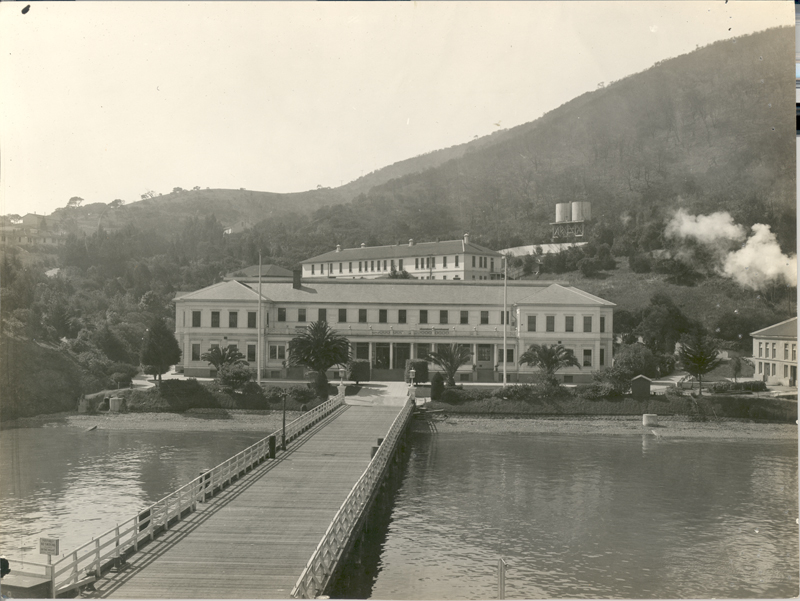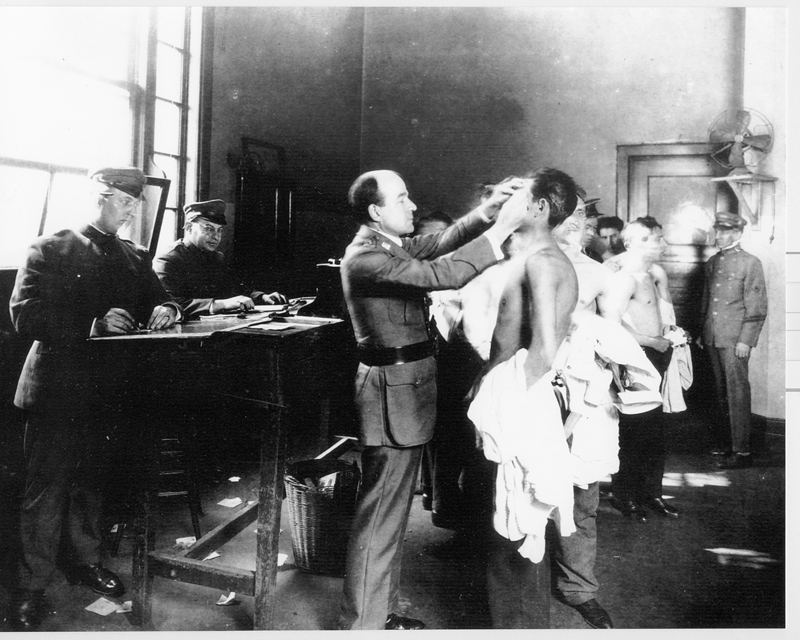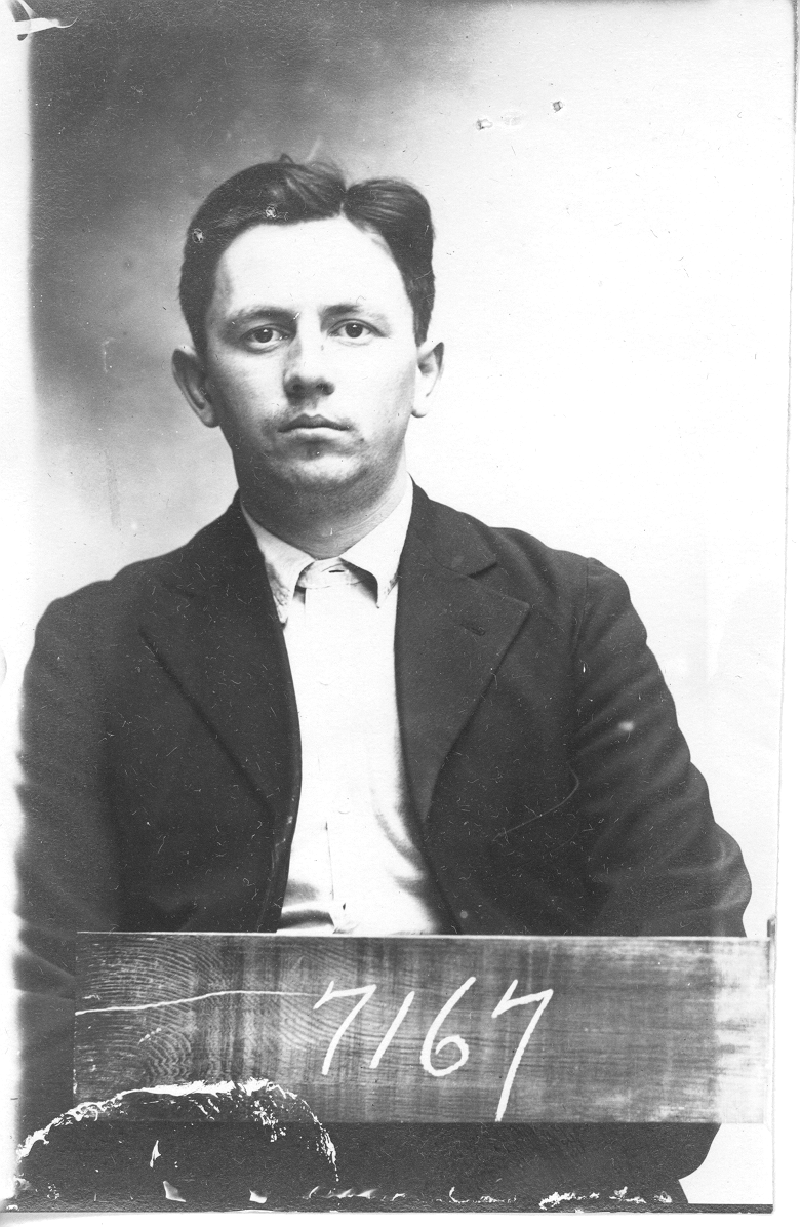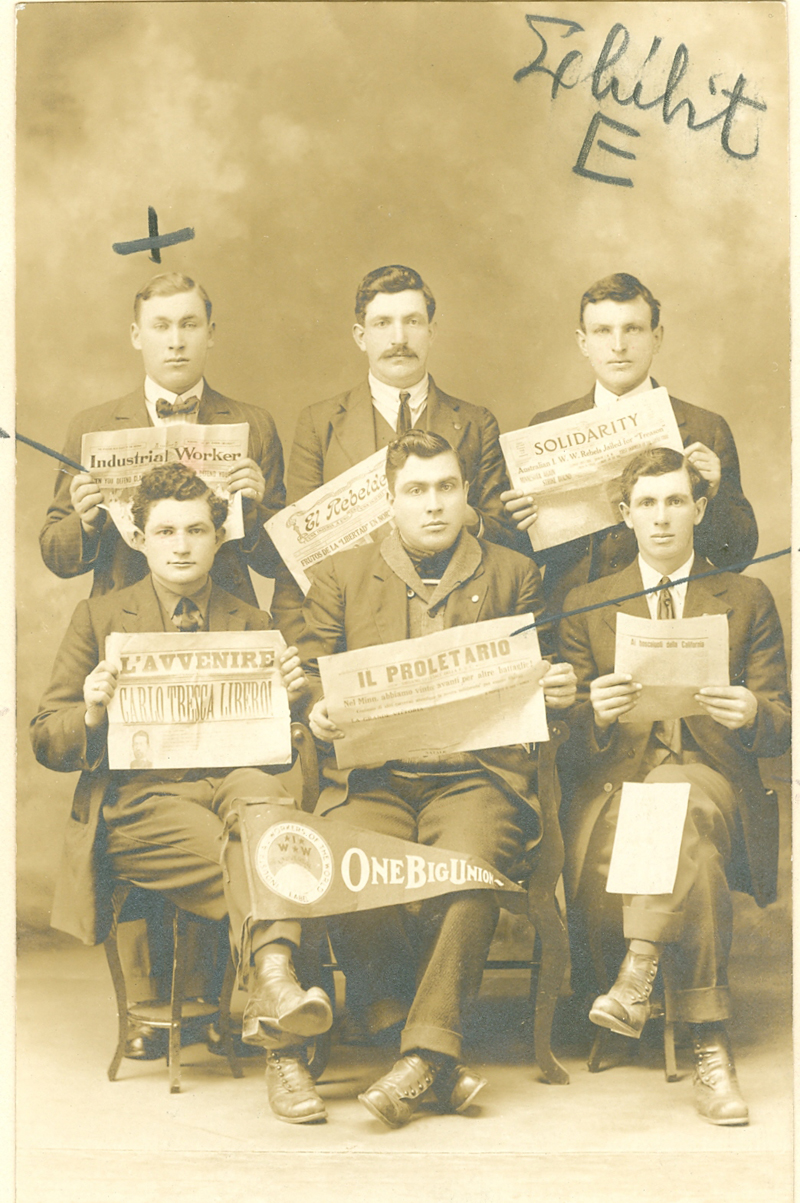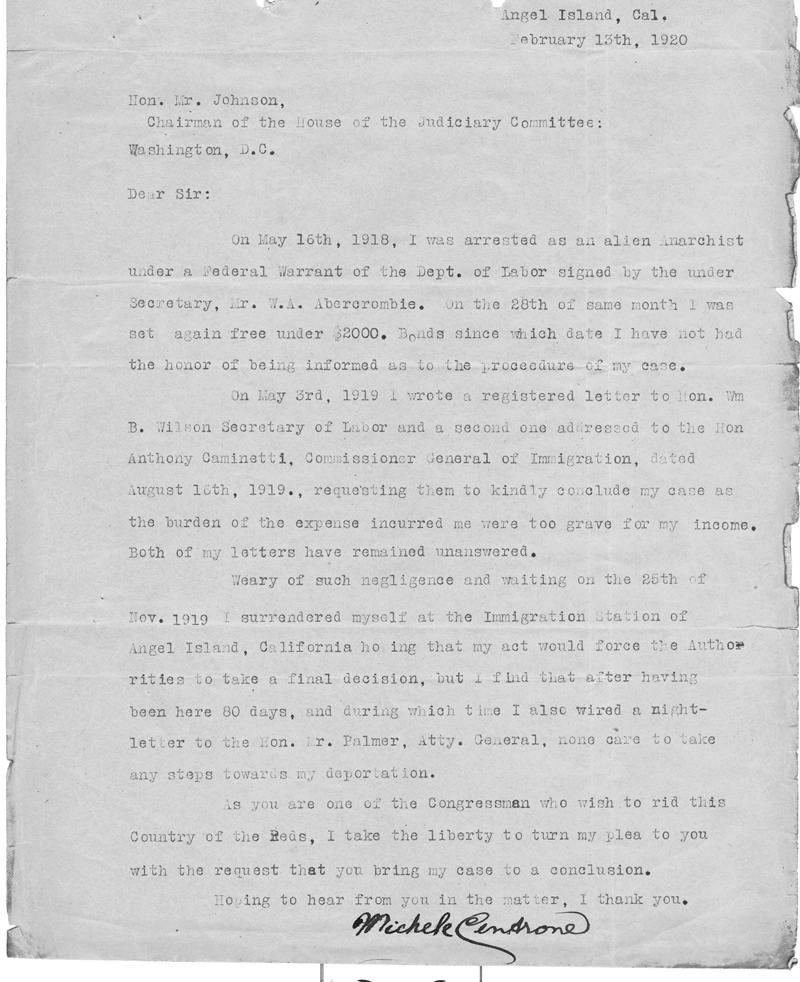
When the “Enemy” Landed at Angel Island
San Francisco Immigration Station Sought to Bar Hostile Aliens and Deport Resident Radicals During World War I
Summer 2009, Vol. 41, No. 2
By Maria Sakovich
©2009 by Maria Sakovich
For three decades, from 1910 to 1940, the Angel Island Immigration Station in San Francisco Bay stood guard as the Pacific Coast’s major entry point for immigrants to the United States—the door through which over a half–million Asians and others from the Pacific rim entered the United States to make new lives for themselves. During the station’s peak years, from 1915 to 1924, non–Asians accounted for one–third of arriving passengers.
With the outbreak of war in Europe in August 1914, immigration across the Atlantic through Ellis Island and other entry points on the East Coast plummeted. Angel Island, however, saw an increase in the numbers of arriving alien travelers and immigrants, especially non–Asians, and many were detained for long periods or barred all together.
Ships from Mexico brought "people of every nationality who [were] fleeing from the terrors of the civil war raging in that country," the San Francisco Commissioner of Immigration reported in 1914–1915. Citizens of the Russian Empire caught in the turmoil of advancing and retreating armies on the eastern front of the war made their way to the West Coast by way of Siberia, Manchuria, Japan, and the Pacific. Between 1915 and 1919, Russian Jewish men, escaping conscription or deserting the army, and later mothers, children, and other relatives of American residents, constituted a large share of the non–Asians arriving at Angel Island.
The U.S. declaration of war in 1917 added two new groups to the already crowded station. Immigration officials were required to detain and interrogate "alien enemies," citizens of Germany and the Austro–Hungarian Empire and resident immigrants under arrest for alleged radical political activity. Especially after the United States entered the war in 1917, anything less than 100–percent loyalty to the American government and American values was suspect. Not only German nationals but also political radicals, including the Industrial Workers of the World (IWW) and other dissenters were perceived as threats to American interests.
The detention of alien enemies and suspected radicals swelled Angel Island’s facilities. Official counts of detained aliens there seem not to have survived, but a few early narratives suggest that the station could accommodate 500 to 600 arrivals at a time without too much difficulty. Detainees were housed in segregated quarters—women and men, Asian and non–Asians. Ethnic groups of any size (such as Chinese, Japanese, Indian, or Russian), were kept together.
During the congestion of the war years, immigrants and travelers might find themselves more crowded than usual as extra beds were added and makeshift rooms were created in the immigration hospital and elsewhere. Some of the second– and third–class passengers never made it to the island at all as their inspections were carried out aboard ship.
With U.S. entry into the war, San Francisco Immigration Commissioner Edward White and his staff, cooperating with the Department of Justice, War Department, and Naval Intelligence, acquired responsibility for the interrogation and custody of more than 800 German (and later Austrian and Hungarian) alien enemies, including a small number of resident alien enemies. San Francisco Bureau of Immigration staff also participated in the federal campaign to eliminate or disable radical organizations by arresting noncitizen radicals and developing cases for deportation. From September 1917 and into 1921, Angel Island inspectors investigated, interrogated, and detained at least 63 resident aliens of several nationalities for their alleged radical political activity.
These new responsibilities fell well within the purview of Angel Island officials. Before as well as after the war, they understood and carried out their primary mandate in a two–pronged fashion—"guarding the gate" against the entry of "unfit" or "dangerous" immigrants and "cleaning house," ridding the country of resident immigrants, Asian and non–Asian alike, who had proven to be less than desirable. America’s entry into the war did not change the mission but demanded extra vigilance.
Alien Enemies
"Alien enemies," as defined by a presidential proclamation of April 6, 1917, were noncitizen males over the age of 14 born in Germany and, as of December 1917, born in the Austro–Hungarian Empire. Only in mid–April 1918 were women declared to be alien enemies, a category some fell into through marriage or through their fathers. The alien enemies detained at Angel Island fell into several groups: seamen working on German ships, seamen working on American ships, German nationals residing in the Philippines (then American territory), ships’ passengers born in enemy countries, and resident aliens.
German Seamen
From April through mid– or late October 1917 the immigration station held approximately 148 crew members who had been removed from German merchant vessels interned in San Francisco, Seattle, Samoa, and Hawaii since the start of the war in 1914. Though not designated prisoners of war, these men seem to have been treated with more consideration than other alien enemies. (The Swiss consul monitored conditions, relaying complaints to both the American and German governments.) Commissioner White offered privileges no other detainees enjoyed, such as use of the wharf before and after hours, swimming in front of the Administration Building, and a special menu. Because of their alien enemy status, however, mail was censored, and visitors were limited. Despite special treatment, complaints about the cramped quarters (separate for officers and seamen), insufficient exercise, delayed mail, and uncertainty about their future led the commissioner to remark in August that the internees "had become a perfect pest." While a few of the German crew members were allowed to apply for parole, most were eventually transferred to the Department of Labor internment camp at Hot Springs, North Carolina. (The status of parole allowed the noncitizen the opportunity to work or to go about one’s life in relative freedom, with weekly check–ins and restrictions on locations where the parolee could work.)
Joining these seamen in 1917 and well into 1918 were German–born seamen working on American ships who had been declared alien enemies a month after the United States entered the war. Perhaps 90 to 100 lost their seafaring jobs when they arrived at San Francisco. Most could apply for admission into the United States or for parole to work while the war continued. A smaller group, however—apparently those who had earlier deserted German ships interned outside of U.S. waters and had taken jobs on American ships—were ordered deported, generally back to ports in Latin America from where they had most recently come. When deportation for some proved impossible, they were transferred to Ellis Island in New York. Time spent in detention at Angel Island varied. Decisions regarding entry or parole took between one and two months. Those ordered to be deported waited at Angel Island for about four months. Those sent to Ellis Island waited between five and seven months (with four men, for unknown reasons, also spending two weeks in the San Francisco jail). Some found the incarceration difficult, especially when they saw others in seemingly identical circumstances allowed to enter or find work under parole. Adolf Babatz, for example, complained in a letter to the San Francisco commissioner that "this internment has had a most awful effect on my nerves, and these are in such a condition as they have never been before, the result of worrying over an internment which I think is not justified. I am really afraid that if I have to stay here much longer the result will be a complete nervous break–down." After less than month, he was deported to Chile. Detention for at least three was too much: Otto Todt, Hans Schnellenger, and Jacob Breuer escaped, only to be apprehended later.
German Nationals from the Philippine Islands
Also interrogated and detained at Angel Island were approximately 170 German nationals sent from the Philippine Islands by the War Department in several groups throughout 1918 for internment in the United States. (These were separate from the group of 450, probably crewmen from vessels interned in Manila, which arrived in mid–December 1917 and were housed at the Quarantine Station until their transfer to Hot Springs a month later and another 60 or so housed at Fort Mason and the Presidio in late 1918.) Some had already been investigated by military intelligence and were described in accompanying reports as "dangerous." Many of the alien enemies, however, were not sure why they had been sent to the United States except for being German. Their various occupations included missionary, priest, planter, chemist, pharmacist, office clerk, civil servant, hotel owner, merchant, marine engineer, housewife. Much to the dismay of the chief of the military intelligence branch of the War Department, the Department of Justice permitted entry and parole for work as well as transfer to internment camps. A number remained at Angel Island beyond the usual two or so months, awaiting decisions on their cases. For a few, a further delay occurred in October, when the local office of the attorney general requested that candidates for parole postpone their interviews until "the present [influenza] epidemic outbreak has passed."
Discharged U.S. Army Soldiers
On June 16, 1918, the U.S. transport Sherman brought 41 young men from Hawaii who had been recently discharged from the U.S. Army because their lack of U.S. citizenship made them alien enemies. Extant files do not reveal why some were eventually admitted under parole to work and others were interned at Fort Douglas, Utah. Most cases appear to have been decided upon by early September 1918, but at least two of these former soldiers were detained much longer, for six and seven months.
Passengers from Enemy Countries
Passengers born in enemy countries were excluded upon arrival, though many fewer case files of this type have survived. The alien–enemy umbrella also covered passengers without proper documents, those whose nationality was in question, stowaways, and those held for special investigation at the request of other government agencies. Women seem to have been detained for shorter periods than men, ranging from a day or two to two weeks. One woman, however, German–born Marie Anna Berg, waited five and a half weeks at the station before being admitted, even though she had the correct documents and was considered a "meritorious case." The detention of male passengers range from two and a half weeks to eight and a half months.
Resident Alien Enemies
Although no case files have survived, the names of at least 18 resident alien enemies can be culled from lists and correspondence found in general chronological files for the immigration station in 1917–1918. Immigration officials arrested these men, born in enemy countries, because they were in violation of the immigration laws (sometimes for simply entering the country without inspection) or had committed a crime and were subject to deportation. Like other alien enemies, they were interrogated and detained at Angel Island (four also spending time in the local jail) while their cases made their way through the Departments of Labor and Justice. The disposition of 11 of the cases (as of August 20, 1918) resulted in the admission of two, release on own recognizance of seven, and the transfer of two to the internment camp at Hot Springs. No further information can be gleaned.
Despite the commissioner’s claim that "the handling of alien enemies’ cases by this Service did not extend beyond their detention and the transmission of their records to Washington for a decision," case files reveal that inspectors and the commissioner himself tried to influence the outcome of the cases, which was in the hands of the Department of Justice. In addition to interrogating alien enemies about their fitness to enter the country under immigration laws, board of special inquiry inspectors probed for information about allegiances and activities during wartime. They asked about the purchase of liberty bonds and contributions to the American Red Cross or to German relief. They asked 18–year–old seaman Walter Loschau, for example, how he would respond to a request by "a representative of the German government to destroy or blow up a public building." The thoughtful answers 49–year–old Lutheran missionary Rudolph Arps provided to questions about where his sympathies lay only provoked further intensive interrogation. Commissioner White recommended denial of entry for Reverend Arps and his wife and daughter (a decision leaving open the possibility of parole), but for salesman Franz Bayer he recommended outright internment. Though Bayer openly acknowledged that he wanted Germany to win the war, he realized it would be financially advantageous to be on the side of the winner, i.e., the United States (in October 1918). Such opportunism suggested not only a lack of loyalty but lack of integrity as well, an attitude that did not sit well with the immigration inspectors.
Though the war ended on November 11, 1918, it was not until June 1919 that the last of the alien enemies left the immigration station at Angel Island. Correspondence and case files provide only a partial picture of what became of the former alien enemies. Though some of the men granted parole to work were still reporting to the San Francisco commissioner in January 1919, by mid–May the reporting requirement and parole restrictions were lifted. If they had been eligible to enter the country under the immigration laws at the time of their arrival, they were free to enter the country, as long as they paid the eight–dollar head tax. (Those brought from the Philippine Islands did not have to pay the tax.).
While alien enemy case files demonstrate vigilance on the part of the Angel Island officials toward activity or sentiments they considered unpatriotic, they also reveal a surprising lack of anti–German feeling. Inspectors seem not to have been caught up in anti–German hysteria that pervaded many communities. Instead, they appear to have carried out their interrogations seemingly free from ethnic prejudice, looking for evidence of harmful activity or misplaced allegiances. Inspectors seemed able to discern between pro–German sympathies and a desire not to fight against one’s kin (in the cases of U.S. alien enemy soldiers reluctant to fight against Germany).
Alien "Radicals"
Such discernment and relative fairness was lacking in their treatment of alien radicals delivered to their care, however. A blatant antiradical bias permeates the files of resident immigrants alleged to have engaged in illegal political activity. So biased were the inspectors at the immigration station that immigrants’ guilt was assumed by association with known radicals, knowledge of IWW songs, and possession of radical literature. Evidence of specific actions was not necessary to secure warrants of arrest.
Concern about foreign radicals was nothing new in the nation, though the 20th century produced the first legislation that excluded immigrants because of their beliefs or associations. In 1903, in reaction to the assassination of President McKinley in 1901, Congress excluded anarchists and provided for their deportation within three years after entry. Congress took further action when a newly galvanized Industrial Workers of the World stepped up its organizing and strike activity in 1916. Responding to pressure from communities frightened by the sensationalized portrayal of these labor disturbances, legislators added another antiradical clause to its 1917 Immigration Act. In the minds of nativists, radical activity was a foreign import, and the IWW, though attracting both American and immigrant workers, was perceived to be a foreign creation.
America’s entry into the war in Europe in April 1917 further fueled the country’s fears of labor agitation and political radicalism. Many Americans believed that not only was the IWW fomenting industrial sabotage, but it was also aiding the enemy. In the atmosphere of heightened suspicion, the federal government initiated a campaign to eliminate or disable the IWW and other radical groups. The Departments of Justice and Labor, the Army (troops and intelligence), and Naval Intelligence participated, along with local law enforcement agencies, in a three–pronged attack on the IWW. Rounding up and deporting noncitizen radicals was the role of the Bureau of Immigration (under the Department of Labor). In 1918 Congress passed yet another immigration act that made it easier to deport noncitizen agitators.
How many individuals were arrested and detained for alleged illegal political activity at the Angel Island Immigration Station during the antiradical campaign (1917–1921) is unknown. Twenty–four case files (along with references to other cases) have surfaced, but files for the 39 warrants of arrest for aliens "of the radical class" mentioned in the Annual Report for 1919–1920 have not been found.
Between mid–1917 and mid–1919, the so–called anarchist cases handled by Angel Island inspectors were initiated by the San Francisco Police Department and the U.S. Department of Justice. Police raids of the "Latin Branch of the IWW" (June 1918) and the Jack London Memorial Hall (January and March 1919), "a place frequented by members of the IWW," resulted in the arrest of French, Italian, British, Austrian, and Russian aliens who were "turned over to the immigration authorities for deportation." The Department of Justice not only kept files on resident aliens, but its agents also used "decoy letters" to ferret out potential radicals.
Angel Island inspectors often interviewed the alleged radicals in a "preliminary hearing," either in the jail to which they had first been taken or at the immigration station. They would then re–arrest them under warrants from the Department of Labor alleging violation of the 1917 or 1918 immigration laws concerning radical activity. Sometimes individuals were under arrest in more than one jurisdiction, and frequently they were detained at Angel Island or in the local jails, or both.
Just being arrested for alleged radical and anarchist activity by the Department of Justice or the San Francisco Police Department prejudiced the immigration inspectors. They did not attempt to conceal their antiradical bias and freely described their charges as, for example, "evidently a radical of the worst type" or "of the type commonly known as ‘Bums.’" The San Francisco commissioner and his staff also exhibited very lax standards of guilt. Inspectors often interpreted possession of IWW or other radical literature or profession of belief in the organization’s principles, and later, mere membership in the organization, as sufficient grounds for deportation. Association with known radicals also implied guilt. About one of the "Latins," the commissioner noted that "when questioned regarding his belief in sabotage and the policy in general of the IWW, he became evasive but his replies had a tendency to support the policy of this organization . . . He is familiar with the IWW songs, which from our knowledge of the same, are along the lines of sabotage and the destruction of property in general."
These alleged alien radicals were frequently detained for lengthy periods of time, as were most radicals arrested throughout the country. An individual arrested under one jurisdiction might be kept in jail for several months before being turned over to the Bureau of Immigration. Several weeks or months might lapse before a preliminary hearing took place. Months at Angel Island would follow. A long detention might also be the result of not being able to afford a bond. (Unlike alien enemies, resident immigrants awaiting decisions on their cases could be freed on bond if they could make the monthly payments.) Many of the IWWs arrested could not afford the $100 payment required for the minimum $1,000 bond. Some of the alien anarchists remained incarcerated in local jails even when under custody of the Bureau of Immigration, which paid for their keep.One detainee, Russian–born Frederick Harold Berger, was put on the long road to deportation when police discovered his IWW membership card when they arrested him for drunkenness in Fresno in September 1917. Four months elapsed before an immigration inspector gave him a hearing at the Fresno jail and the Department of Labor issued a warrant of arrest. A month later, Army Intelligence transferred him to San Francisco City Prison for four weeks, where he was rearrested under warrant by the Department of Labor. Finally, Berger was taken to Angel Island, where he was given a second hearing, resulting in a warrant for deportation. For the next 12 months he remained at the immigration station until he was transferred to San Francisco County Jail as a "dangerous character," where he remained for four more months until taken to Ellis Island. There he was incarcerated for another six months, denied legal assistance, and finally deported on the USS Buford, December 21, 1919, along with 248 other immigrant radicals, including Emma Goldman.
The length of detention was sometimes as much a problem as the deportation itself. Italians Michele Centrone and Giuseppe Scale (described by the Department of Justice as "active workers for the anarchistic propaganda"), "weary of such negligence and waiting," wrote to the highest authorities for resolution of their cases. In their letters they described the hardship of limbo and expressed their poignant hope for action on their cases. Sometimes the long wait and uncertainty, even at liberty, caused difficulty. After two weeks at Angel Island and a year out on a $2,000 bond, Centrone wrote to the secretary of labor and to the commissioner general of immigration, "requesting them to kindly conclude my case as the burden of the expense incurred me were too grave for my income." In hopes of action, he finally surrendered himself to the officials at Angel Island. After 80 days at the station, during which time he even telegraphed Attorney General A. Mitchell Palmer (chief organizer of the raids conducted in November 1919 and January 1920, later known as the "Red Scare"), he wrote the arch anti–immigrant and anti–IWW congressman Albert Johnson, pleading for a decision on his case. Five weeks later, he boarded a deportation train for Ellis Island, from where he was finally deported.
Even when the bureau decided not to deport the individual, the process of arrest, interrogation, and detention could severely disrupt one’s life. Hubert John Levy, an English–born Australian, employed boat builder and shipwright, and four–year resident of San Francisco, was arrested as a result of his answers to a decoy letter sent by a Department of Justice agent posing as an IWW organizer. After about two months at Angel Island, Levy asked to return to Australia at his own expense (thereby avoiding being legally deported). Commissioner White granted his request (without notifying Washington). On the day Levy left, however, a telegram arrived postponing a final decision on Levy’s case and releasing him on his own recognizance—"there is nothing to indicate that [Levy] has taken any active part in propaganda work or has become a member of the IWW or any other organization." Unfortunately the telegram arrived after Levy’s ship sailed.
Officials at Angel Island and in Washington wanted to deport as many immigrants as possible whose political activities they regarded as illegal. Case files and reports, however, reveal mixed results from their efforts. Of 22 cases found for 1917–1919, possibly only four resulted in deportation; warrants of arrest were canceled in at least nine instances. Of the 39 cases reported for 1919–1920, five resulted in deportations, and warrants of arrest were canceled in 31 cases. As Levy’s case demonstrates, despite cancellation of warrants and deportation, the cost to immigrants could be high. Arrest, interrogation, and detention could significantly alter life courses.
Although extant case and correspondence files do not tell the whole story of these two detained populations at the Angel Island Immigration Station, what has survived provides an overview as well as insight into these little–known episodes at the major port of entry on the West Coast during World War I. The records portray major disruptions in people’s lives, always an inconvenience, but more likely deprivation of freedom, loss of livelihood, and lives put on hold. They also document the activities of government officials during a time of greatly heightened tensions and passions. At Angel Island, immigration officials accustomed to "guarding the gate" and "cleaning house" during times of peace found themselves with added duties and new populations. They operated both conscientiously and zealously, sometimes to the advantage of their charges, sometimes to their detriment.
Maria Sakovich is a public historian and independent scholar who researches, writes, and develops exhibits in the areas of immigration, family, and community history. She has written articles on Methodist women including Deaconess Katharine Maurer, a beloved social worker at the Angel Island Immigration Station. The story of the Russian refugees who arrived in San Francisco in the early 1920s following the Bolshevik revolution and civil war is the subject of her next book.
©2009 by Maria Sakovich
Note on Sources
The National Archives and Records Administration–Pacific Region in San Bruno, California, contains case and correspondence files of the Angel Island World War I alien enemies in Record Group 85, General Records of the Immigration and Naturalization Service. Case files include interrogation transcripts and correspondence between local department officials (Immigration and Justice) and their superiors in Washington and petitions for entry, usually with photographs. Sometimes an individual’s file is augmented by letters from shipping companies, the San Francisco Police Department, and other agencies involved in cases. Occasionally adding to the narrative are letters from the detained alien enemy himself. Correspondence files include some individual cases as well as lists which provided additional names and sometimes wartime destinations after the immigration station and less frequently postwar outcomes. Case files of alleged radicals are part of Record Group 85 (Accession 60A600) at the National Archives, Washington, D.C. Also included in these files is IWW literature confiscated during police raids. Quotations in this article come from the case and correspondence files.
Most helpful for understanding these episodes in American history are John Higham’s Strangers in the Land: Patterns of American Nativism, 1860–1925 (1984 edition with new preface); William Preston, Jr.’s Aliens and Dissenters; Federal Suppression of Radicals, 1903–1933 (2nd ed., 1994); Maria Sakovich, "Angel Island Immigration Station Reconsidered: Non–Asian Encounters with the Immigration Laws, 1910–1940," (MA thesis, Sonoma State University, 2002); and Jörg Nagler’s "Victims of the Home Front: Enemy Aliens in the United States during the First World War (in Panikos Panayi, ed., Minorities in Wartime, 1993).Many thanks to archivists Bill Greene in San Bruno, who alerted me to the World War I correspondence files and who always responded expeditiously and graciously to my requests for case files, and to Suzanne Harris in Washington, D.C., who patiently located or tried to locate hundreds files I requested for my MA thesis research, including the "anarchist" files. She also screened the files in good time.
